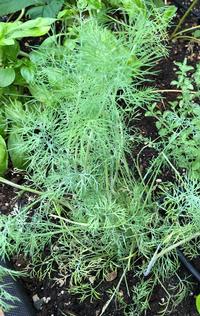Dill

How to grow
- Type: Summer annual
- Light: Full sun
- Soil: Well drained
- Water: Needs regular watering until established, then allow soil to dry between waterings. Do not overwater
- Size: 2-4' high, 18-24" wide, depending on variety
When to plant/propagate
Dill typically grows to about 3' tall. Stake plants if needed. New leaf production stops when plants bloom. For a steady supply of fresh leaves, make successive plantings a few weeks apart.
- From seed: Sow seeds March-May (possibly June) or Sep-Oct
- Transplants: Young seedlings will work best. Plant seedlings March-May or Sep-Oct
Harvesting
- For leaves, harvest as soon as they are big enough to be useful
- For seeds, cut seed heads 2-3 weeks after blooming (before they turn tan). Place heads in a paper bag and hang in a dry location. Collect the seeds after they have dried and fallen off
Indoors: Can be grown indoors, but needs 5-6 hours/day of bright light from a sunny window or 12-16 hours of supplemental light provided by cool white fluorescent or LED lamps
Common pests & diseases: Aphids
More information
- Growing Dill (Anethum graveolens), UC Master Gardeners of Sonoma County
- Easy Gardening - Dill, Texas A&M AgriLife Extension
Recommended Varieties for Santa Clara County*
See our list of Spring Garden Fair Herbs for varieties that we have found perform well here.
*Many other varieties may also do well here in Santa Clara County. This list is based on UC Master Gardener trials, taste tests, and feedback from local growers.






